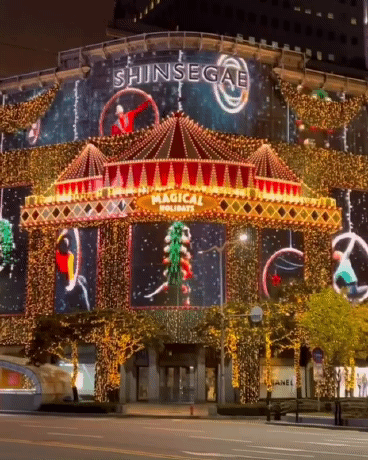Why Seoulites are lining up two hours for a Christmas tree
Hint: the tree is a post-Covid metonym
It’s true. People are waiting two hours to see a Christmas tree in Seoul.
A caveat: this isn’t any Christmas tree. It’s a whopping 13 meters in height, bespeckled with plush, red teddy bears, draped in sparkling color-changing lights, and located inside Seoul’s largest department store The Hyundai.
This is how my facial muscles probably rearranged themselves after seeing the queue in front of the tree.
Amidst my surprise/horror though, I was fascinated by the crowd. Young couples eagerly eyed the photogenic scene, mothers pulled children towards the ever multiplying line and bemused elderly folk took in the whole spectacle from a distance.
Since when were Seoulites this passionate about Christmas?
Festive yearnings in the wake of Covid
I first arrived in Seoul in 2009. It’s been more than ten years since, and during this period leading up to 2020 I noticed something: Seoul isn’t big on Christmas. No carols. No Christmas decorations sprawling across buildings in Harrod-esque fashion. Just the occasional tree sparsely adorned with small, twinkling lights.
There’s nothing inherently wrong about a non-Christmasy city. It just sucks.
If you look at Seoul’s hardcore work-driven history though, it’s no surprise. The city’s “Han Miracle” work ethos catapulted South Korea to being one of the top ten exporters in the world within just fifty years of being liberated from colonialism (1945) and being wracked by civil war (1950-53).
Long story short, Seoul is all about work, work, work (minus Rihanna).
This isn’t to say that Seoulites are stoic, work-oriented, soulless beings with no cravings for a bit of Christmas jolly. In fact, it’s quite the opposite. Seoulites love festivity. It’s just that the city could never quite “find the time” to express this fully.
Enter Covid-19.
Quarantines, social-distancing, and face masks snuffed out what little mirth Seoul was capable of expressing as a utilitarian city. The funny thing is, not doing something arbitrarily is different from not being able to do it. The pandemic seems to have made Seoul realize this—realize that we should embrace a culture of celebration and warmth when we can and not relegate it to the realm of frivolity. Celebrating our achievements is just as, if not more, important as being productive.
Kickstart and monopolize the holiday spirit
Shinsegae tapped into this post-Covid yearning for celebratory expression when they transformed the facade of their main department store building into a digital winter wonderland in 2021.
They ushered in a never-before-seen holiday spirit into Seoul with such vigor, celerity and ostentatiousness that “Shinsegae” became synonymous with Christmas for that season. People flocked to see the dazzling LED screens come alive with jovial elves and reindeer, and cars slowed to a near halt when passing by—much to the chagrin of Lotte, another department store down the street that was obviously caught off-guard.
Shinsegae essentially kickstarted a new phase in Seoul’s history. A phase through which Seoulites and brands alike viscerally felt a long awaited change overcome Seoul. The city was finally warming up to the idea of celebrating the holiday season. Fast-forward a year later, department store brands e.g. Hyundai, Lotte, Galleria are vying to secure the title of “best dressed” so as to attract not so much a crowd of potential shoppers, but rather to imprint into the public mind that they are joy.
People learn best when they like something. Department stores want passerby, customers, the public to associate their brand with the positive emotions induced by the holiday season: buoyancy, thankfulness, a willingness to give. Emotions that will paint your perception of a brand with a rosiness that will, in turn, compel you to relive your memories of that brand every holiday season. This is the beginning of a long-term relationship between customer and brand that can only be usurped if the latter fails to uphold and reconstruct the holiday fantasy they initially promised.
Make it real to win
The move by Shinsegae was not innovative, per se. But they acted when no one else did. There was always a deep yearning for overt celebration within the hearts of Seoulites, a pining that grew even more palpable under Covid, and this desire was finally expressed via Shinsegae’s Christmas decor.
The key takeaway here is that identifying, understanding, and acting on what people want is what makes a winning brand.
Shinsegae fulfilled a need that had long been overdue: magical, holiday sentiment. Almost anyone who lived in Seoul before Covid would agree that Seoul was missing out on Christmas year after year. Seoul is now no longer the same city.
The queue in front of The Hyundai’s resplendent tree demonstrates that Seoulites are still passionate as ever to imbibe the uplifting mood and capture the moment in a photo. Does this warrant a two hour wait? Maybe, maybe not.
What’s certain is that Seoul is reveling in this new-founded spirit of conviviality and neither brands nor Seoulites intend on missing out.





